List of largest craters in the Solar System
Appearance
Following are the largest craters on various worlds of the Solar System.
| World | Crater | Diameter | Diameter of parent body |
Ratio | Notes | |
|---|---|---|---|---|---|---|
| Mercury | Caloris Basin | 1,550 km (963 mi) | 4880 | 32% | 
| |
| Rembrandt | 715 km (444 mi) | 15% | 
| |||
| Venus | Mead | 280 km (170 mi) | 12,100 | 2% | File:Mead crater.gif | |
| Earth | Vredefort | 250–300 km (160–190 mi) | 12,740 | 2% | 
| |
| Moon | South Pole – Aitken basin | 2,500 km (1,600 mi) | 3470 | 70% | 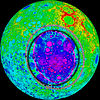
| |
| Mare Imbrium | 1,145 km (711 mi) | 33% | 
| |||
| Mars | North Polar Basin | 10,600 × 8,500 km (6,550 × 5,250 mi) | 6780 | 140% | 
|
Not confirmed as an impact basin |
| Hellas Planitia | 2,300 km (1,400 mi) | 34% | 
|
Largest visible crater in the Solar system | ||
| Vesta | Rheasilvia | 505 km (310 mi) | 529 (569)[1] | 90%[1] | 
|
See also List of tallest mountains in the Solar System |
| Veneneia | 395 km (250 mi) or 450 km (280 mi) | 70–80%[1] | 
|
Partially obscured by Rheasilvia | ||
| Ganymede (Jupiter) | Epigeus | 343 km (213 mi) | 5270 | 6½% | ||
| Callisto (Jupiter) | Valhalla | 360 km (224 mi) | 4820 | 7½% | 
| |
| Heimdall | 210 km (130 mi) | 4% | ||||
| Mimas (Saturn) | Herschel | 139 km (86 mi) | 396 | 35% | 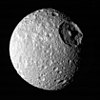
|
See also List of tallest mountains in the Solar System |
| Tethys (Saturn) | Odysseus | 445 km (277 mi) | 1060 | 42% | 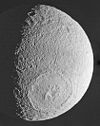
| |
| Dione (Saturn) | Evander | 350 km (220 mi)[2] | 1023 | 34% | 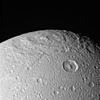
| |
| Rhea (Saturn) | Mamaldi | 480 km (300 mi)[3] | 1530 | 31% | 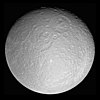
| |
| Tirawa | 360 km (220 mi) | 24% | 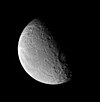
| |||
| Titan (Saturn) | Menrva | 392 km (244 mi) | 5150 | 7½% | ||
| Iapetus (Saturn) | Turgis | 580 km (360 mi) | 1470 | 39% | 
| |
| Engelier | 504 km (313 mi) | 34% | 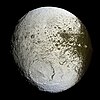
| |||
| Gerin | 445 km (277 mi) | 30% | 
|
Gerin is overlain by Engelier | ||
| Falsaron | 424 km (263 mi) | 29% | File:Iapetus mosaic color.jpg | |||
| Titania (Uranus) | Gertrude | 326 km (203 mi) | 1580 | 21% | 
|
Little of Titania has been imaged, so it may well have larger craters. |
